MARIANI’SVirtual
Gourmet
April
6, 2014
NEWSLETTER
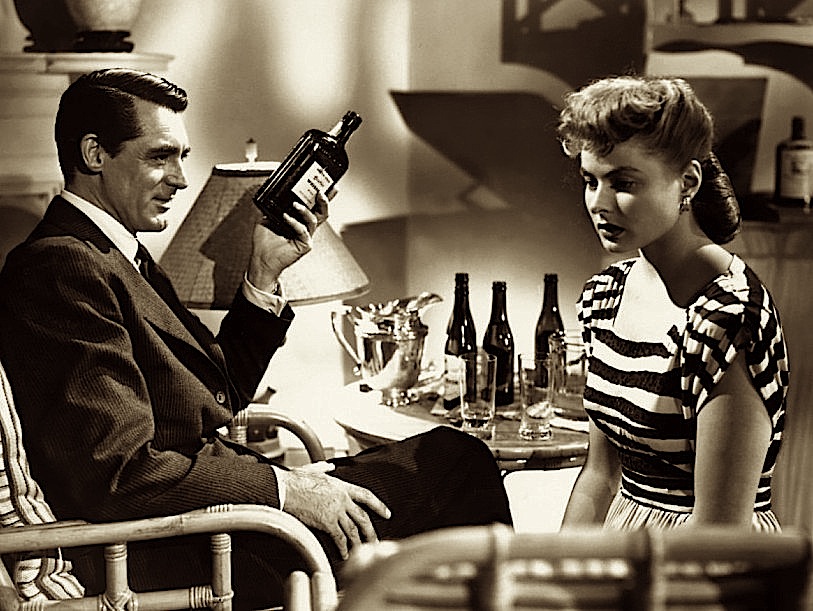
Cary Grant
and Ingrid Bergman in "Notorious" (1946)
IN THIS ISSUE
DINING OUT IN CHARLESTON
By John Mariani
NEW YORK CORNER
TWO CASUAL ITALIAN TRATTORIAS
By John Mariani
NOTES FROM THE WINE CELLAR
Wines I'm Drinking for Spring
By John Mariani
❖❖❖
DINING OUT IN CHARLESTON
By John Mariani
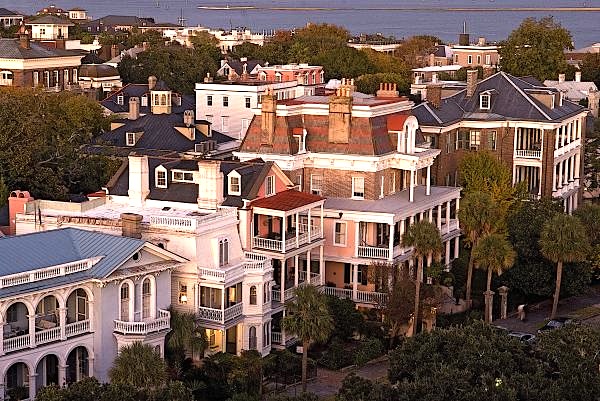
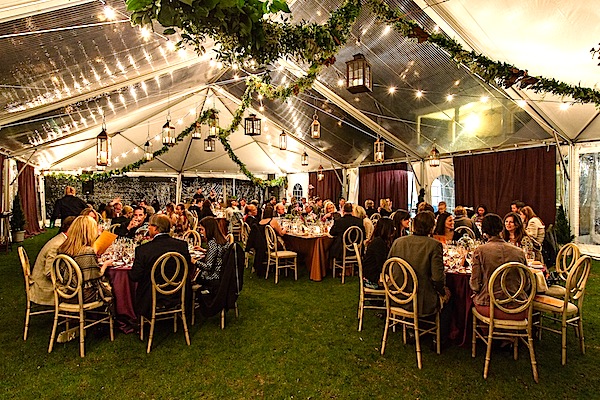 entirely
on the same tired TV food and travel show
celebrities, Charleston celebrates new
people each year, and they have a lot of
great talent to choose from. The
"Heart of the Festival" is the tented
Culinary Village (left), where
back-to-back demos, book signings, and
music jams are held throughout each day.
Testament to the success and popularity of
the Festival is not just that it's grown,
but that its various events sell out weeks
in advance.
entirely
on the same tired TV food and travel show
celebrities, Charleston celebrates new
people each year, and they have a lot of
great talent to choose from. The
"Heart of the Festival" is the tented
Culinary Village (left), where
back-to-back demos, book signings, and
music jams are held throughout each day.
Testament to the success and popularity of
the Festival is not just that it's grown,
but that its various events sell out weeks
in advance. Next year I expect it to be bigger and better than ever. Of course, I got to eat around town, including some new places opened since the last Festival, all showing the traditional depth and the continuing innovation of the city's cuisine. Charleston, in just a few years, has emerged as one of America's most enticing dining cities, and there's much more to come.
CYPRESS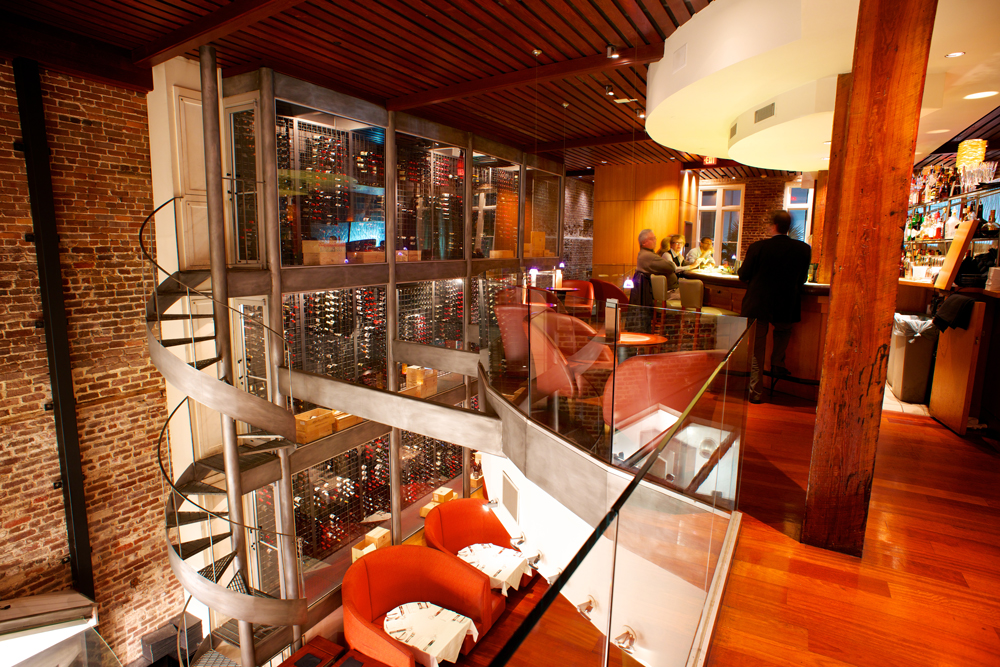
167 E. Bay Street
843-727-0111
cypresscharleston.com
Upon
its opening in 2001, I pronounced Cypress to be one
of America’s Best New Restaurants in Esquire;
now, 13 years later, I can safely say it is one of
America’s Very Best. Period. A decade ago
Cypress represented a significant leap forward in
design that shied away from the then typical Low
Country genteel dining room look. The place
was vast, with a great wall of wine behind glass, an
open kitchen, and dramatic lighting. (The
company that owns Cypress also runs the estimable
Magnolias and Blossom.)
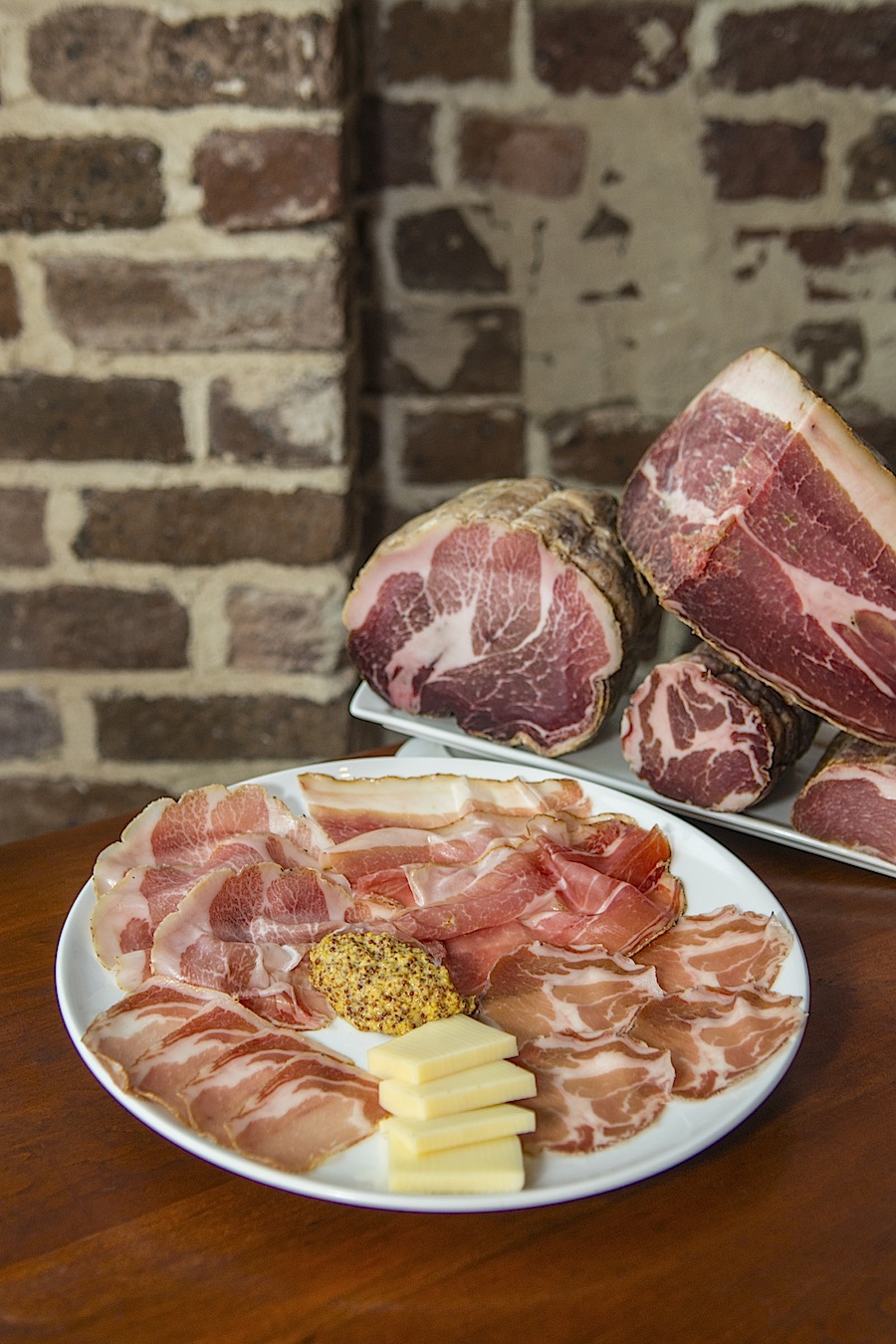 Today, Craig Deihl, Pennsylvania-born
but Charleston-trained, is the chef, and he is
toeing the line of sumptuous, modern Low Country
cuisine, and, as a founding member of the Butcher’s
Guild, has added to it an array of house-made
charcuterie (left)
that is positively daunting--80 varieties, a score
of which are offered on any given evening--and they
are some of the finest I’ve tasted anywhere in this
country. (He’s done a Cypress cookbook and was
chosen in 2010 as Chef of the Year by the Charleston
chapter of the American Culinary Foundation.) The
choices are amazing--andouille, apple cider salami,
bologna, jerky, bratwurst, bresaola, and so many
more, all with condiments and mustards and pickles
on the platters, which range from $12 to $20.
Today, Craig Deihl, Pennsylvania-born
but Charleston-trained, is the chef, and he is
toeing the line of sumptuous, modern Low Country
cuisine, and, as a founding member of the Butcher’s
Guild, has added to it an array of house-made
charcuterie (left)
that is positively daunting--80 varieties, a score
of which are offered on any given evening--and they
are some of the finest I’ve tasted anywhere in this
country. (He’s done a Cypress cookbook and was
chosen in 2010 as Chef of the Year by the Charleston
chapter of the American Culinary Foundation.) The
choices are amazing--andouille, apple cider salami,
bologna, jerky, bratwurst, bresaola, and so many
more, all with condiments and mustards and pickles
on the platters, which range from $12 to $20.
My wife would have happily gorged
on the charcuterie and gone no further on the menu,
but I’m glad we did, because the lobster bisque with
shrimp and chervil ($10) was superb and a generous
plate of chicken and dumplings ($26) was warming on
a very rainy night, chock full of chicken and homey
in the best way. So, too, was a side of peas
and gold rice scented with saffron, 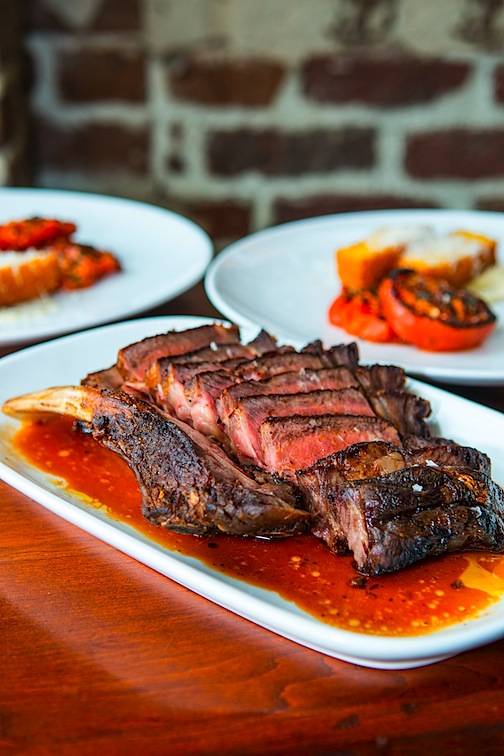 cumin and bacon.
Scallops were married to pork belly ($32) very
honorably, enriched with caramelized onions, sweet
potatoes, a luscious bacon jam and curried raisins.
cumin and bacon.
Scallops were married to pork belly ($32) very
honorably, enriched with caramelized onions, sweet
potatoes, a luscious bacon jam and curried raisins.
A duo of
American lamb cuts ($36) with polenta, turnips,
mustard, apples, radishes and celery seemed as much
vegetarian as carnivorous. But for the bigger
meat-eaters go for the superb grilled ribeye (right) for two
at a very reasonable $56. (Ask them for the best aged ribeye
they have; there is quite a difference.)
Desserts are every bit as good
here, from a chocolate crème caramel with
raspberry coulis and Madeira reduction ($8) to a
terrific buttermilk tart laced with bourbon and
accompanied by an orange-tamarind puree Chantilly
cream and citrus candies ($8).
Cypress’s wine list is among the
finest in the South, with hundreds of well-chosen
bottles from every corner of the Earth.
Open
for dinner nightly.
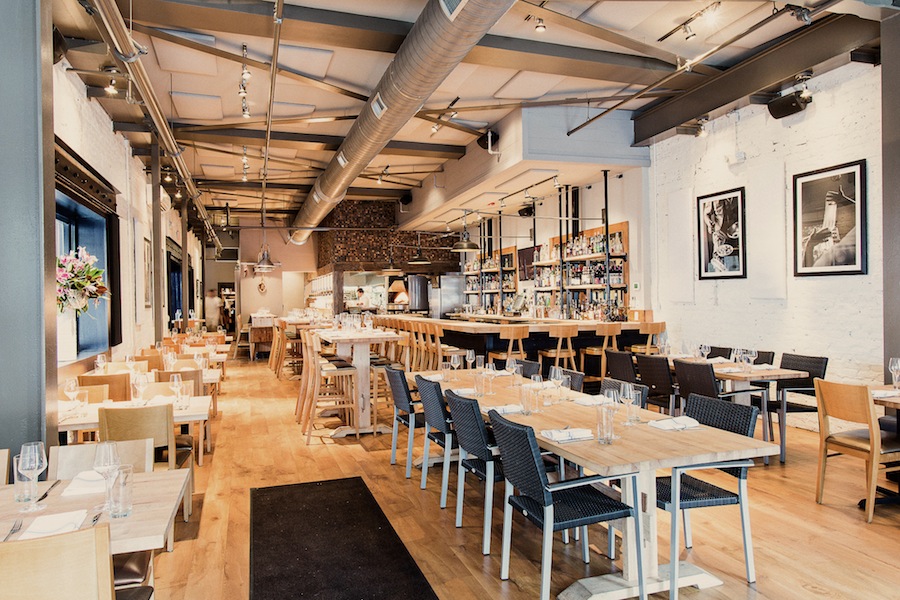 INDACO
INDACO
526 King Street
843-727-1228
indacocharleston.com
Charleston’s
most prominent restaurateur, Steve Palmer, is at it
again. As the developer of first-rate restaurants
around town, his Indigo Road Hospitality Group has
opened Oak Steakhouse, O-Ku, The Cocktail Club, The
Macintosh, The Oak Table, and, this year, Indaco.
Palmer has an uncanny sense of what the Charleston
market is absolutely ripe for, and, since the
Italian offerings around the city have been
dismal--with the notable exception of Ken
Vedrinksi’s tiny Trattoria Lucca--Indaco is a
significant addition to the genre.
It’s a
long dining room set off upper King Street, and the
place gets very loud as the evening progresses.
(It's also much darker than the photo at left
indicates.) Unlike so many Charleston
restaurants, people keep coming in after 9 PM.
A reservation in advance is highly
recommended, since Indaco is unquestionably the
city’s new hot spot.
Exec chef
Michael Perez (right),
originally
from Portland, Oregon, brings a good
résumé to Indaco, which includes work
at Scarpetta in Beverly Hills and Las Vegas,
although his never (as yet) having set foot in Italy
shows in a few dishes that are more elaborate than
they should be. Even so, a lavish antipasto
of raw snapper ($14) was first rate, anointed with
black olives, celery, radish, pickled mustard seeds,
jalapeños, olive oil and lemon. So,
too, very refreshing was a panzanella
salad ($15) with burrata,
spring onions, basil, arugula and Parmigiano. 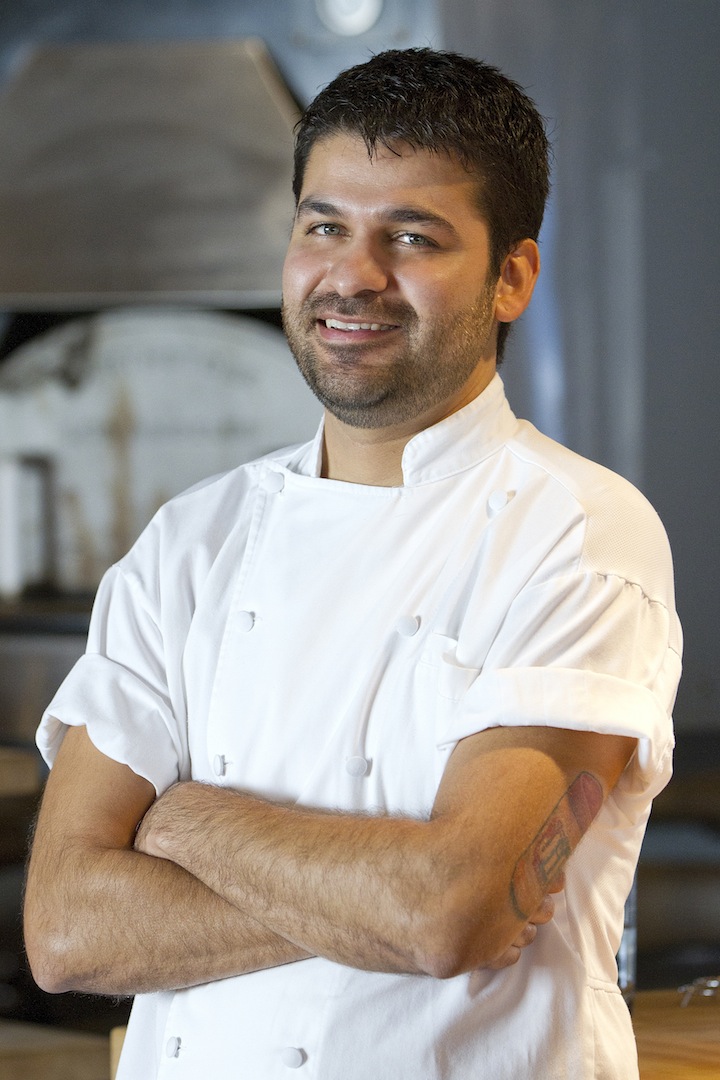
We tried too pizzas, one a
classic Margherita ($16), which was fine, but an
unusual octopus pizza ($17) with tomato, fontina,
broccoli di rape and Calabrian chili was overwhelmed
by salt and thus tasteless.
Indaco’s pastas, as at most
Italian restaurants, are what most people will want
to order, including delicious agnolotti
($24) with beef short rib, pickled shallots, salsa verde
and pecorino sprinkled on top. Pappardelle
($24) were treated to a pork sugo,
herb-whipped ricotta, orange and pecorino, while
black pepper tagliatelle
($22) was a variation on Roman carbonara,
with pork, egg yolk, chives, and pecorino.
Rather bland, however, was the risotto ($22),
overcooked that evening, with grilled pork cheeks,
Parmesan, chives and a balsamic vinegar.
There are four secondi on
the menu, though roasted tuna with coriander,
fennel, pea shoots ad grapefruit had too much going
on on the plate. The wine list, as any Palmer
compiles, is very well selected and all Italian,
with dozens of bottles under $50. Red wines
may arrive too warm, however.
Indaco is pumping on all
cylinders right now and with a bit more finesse and
a few less ingredients, it should evolve into a very
good Italian trattoria before too long, especially
after Chef Perez visits Italy later this year.
Indaco
is open nightly for dinner.
THE GRANARY
624-L Long Point Road
Mt. Pleasant, SC
thegranarycharleston.com
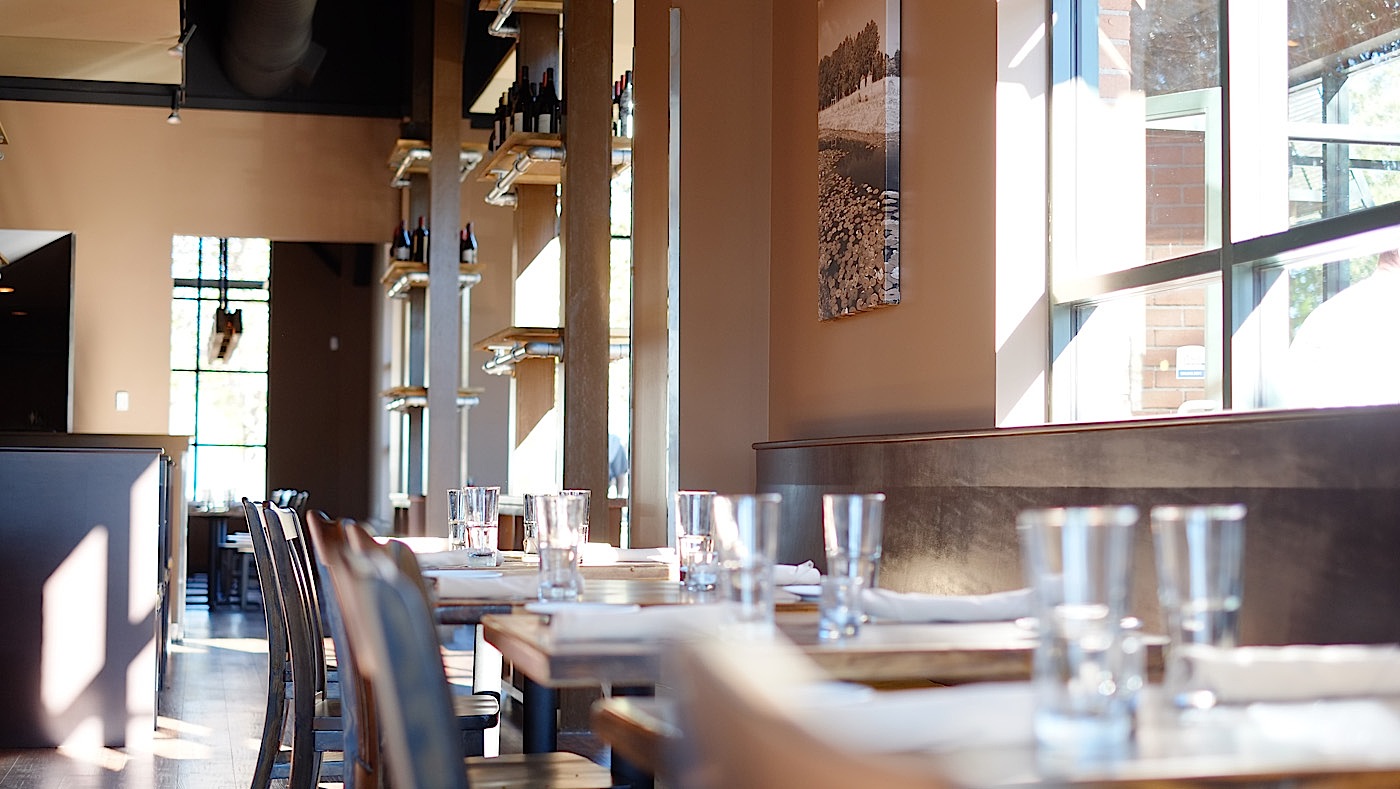 Cross
over the sweeping Ravenel Bridge and pretty soon
you’ll come to the quickly developing town of Mt.
Pleasant, where, in the nondescript Belle Hall
shopping center is a restaurant that might well be
worth the drive, if only to see what chef-owner
Brannon Florie is doing here.
Cross
over the sweeping Ravenel Bridge and pretty soon
you’ll come to the quickly developing town of Mt.
Pleasant, where, in the nondescript Belle Hall
shopping center is a restaurant that might well be
worth the drive, if only to see what chef-owner
Brannon Florie is doing here.
The
overuse of the term “farm-to-table,” especially in
Southern restaurants, rarely turns out to have much
truth to the claim, but Florie is adamant about
sourcing his produce, chicken, duck, eggs, lamb and
pork from McClellanville’s Thornhill Farms, and he
makes his own charcuterie, breads and pastries. set
out on family-style plates.
There is
space for 75 people inside, including a chef’s table
and communal bar table. The restaurant is friendly,
casual, and very, very good. I really loved
the duck confit
with Charleston Gold rice, 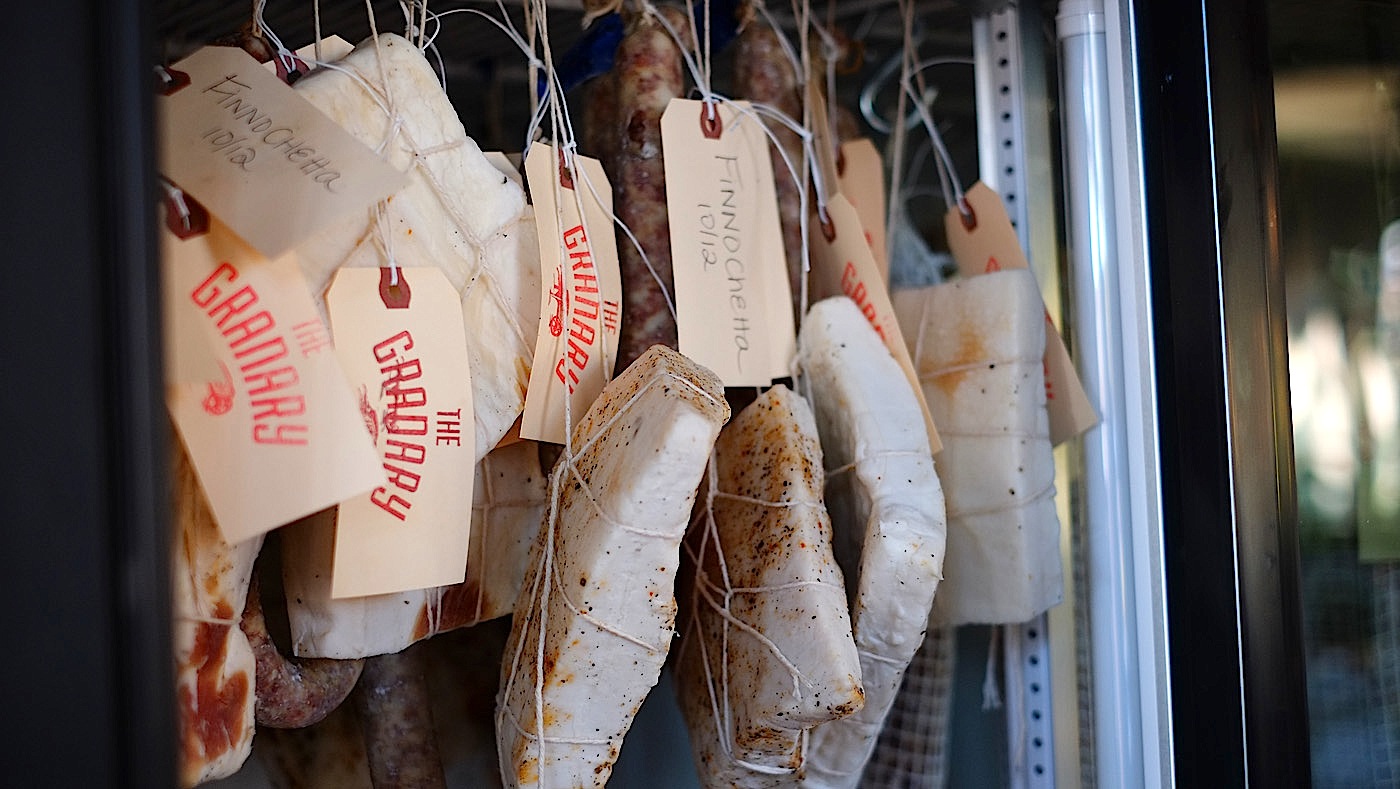 crowder peas (you rarely
see these), kale (you see way too much of this), and
a flavorful egg sunny side up. Pork belly is
good thick bacon, not too salty, with stone ground
grits--which make a big difference--another egg, pesto and
pecorino. I might have been entirely happy
with just the platter of beautiful heirloom
tomatoes, watermelon radish, basil and goat’s cheese
dressed with sherry vinaigrette.
crowder peas (you rarely
see these), kale (you see way too much of this), and
a flavorful egg sunny side up. Pork belly is
good thick bacon, not too salty, with stone ground
grits--which make a big difference--another egg, pesto and
pecorino. I might have been entirely happy
with just the platter of beautiful heirloom
tomatoes, watermelon radish, basil and goat’s cheese
dressed with sherry vinaigrette.
The main
dishes I liked were an organic chicken with
butternut squash, puckery preserved lemon, olives,
onions, pickled cauliflower and cous cous, which
strayed far from Low Country cookery, but Florie won
me back with a truly wonderful, very tasty
vermillion snapper with a carrot and curry puree,
new potatoes, spinach and a brown butter orange
vinaigrette. Acid is an important flavor brightener
in Florie’s cooking.
For
dessert the way to go is with the simple almond cake
gussied up with rich crème anglaise, Meyer
lemon whipped cream, and an almond tuile.
Some of
Florie’s dishes would probably be improved if they
were not quite so fussy with so many ingredients.
But the flavors are true, honest and, for the
most part, authentic, showing what can be done when
the farm-to-table mantra really means something.
The Granary is open for dinner; lunch and brunch.
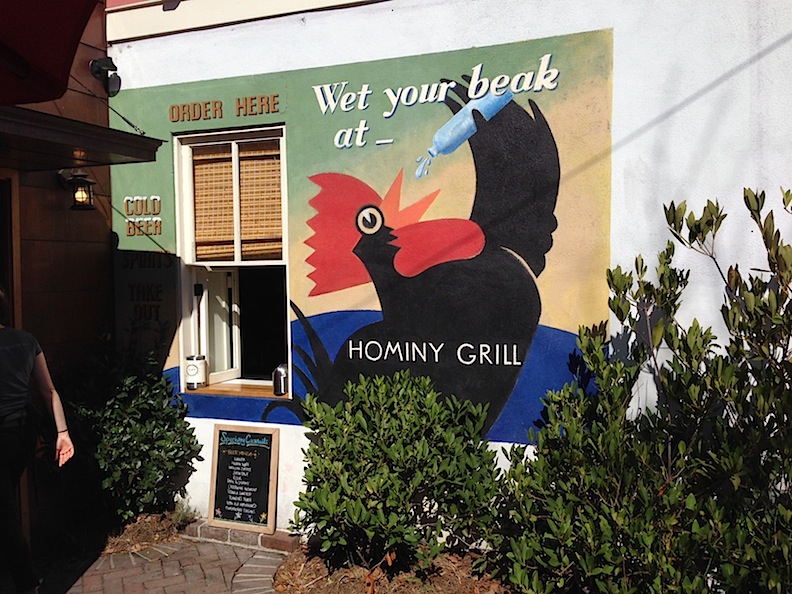 HOMINY
GRILL
HOMINY
GRILL
207 Rutledge Street
843-947-0930
.hominygrill.com
I
consider it as much a sorry omission to miss eating
at least one meal at Hominy Grill as to go to Venice
and not drop into Harry’s Bar. For both are
icons, for very different reasons: one is an
international watering hole famous for its bellinis
and carpaccio; the other is a down-home eatery
equally famous for its catfish Creole and shrimp
bog. Guess which is which?
Located, since 1996, in a
pink and white shotgun house dating to 1897,
recently appended with another dining room, Hominy
Grill is bright, with antique tin ceilings and
slow-moving fans, wooden floors, captain’s chairs,
and windows that let in the Low Country sun.
You could not wish for a more amiable,
friendly staff, which is crucial to keep the long
lines of waiting guests at bay in the hot South
Carolina sun.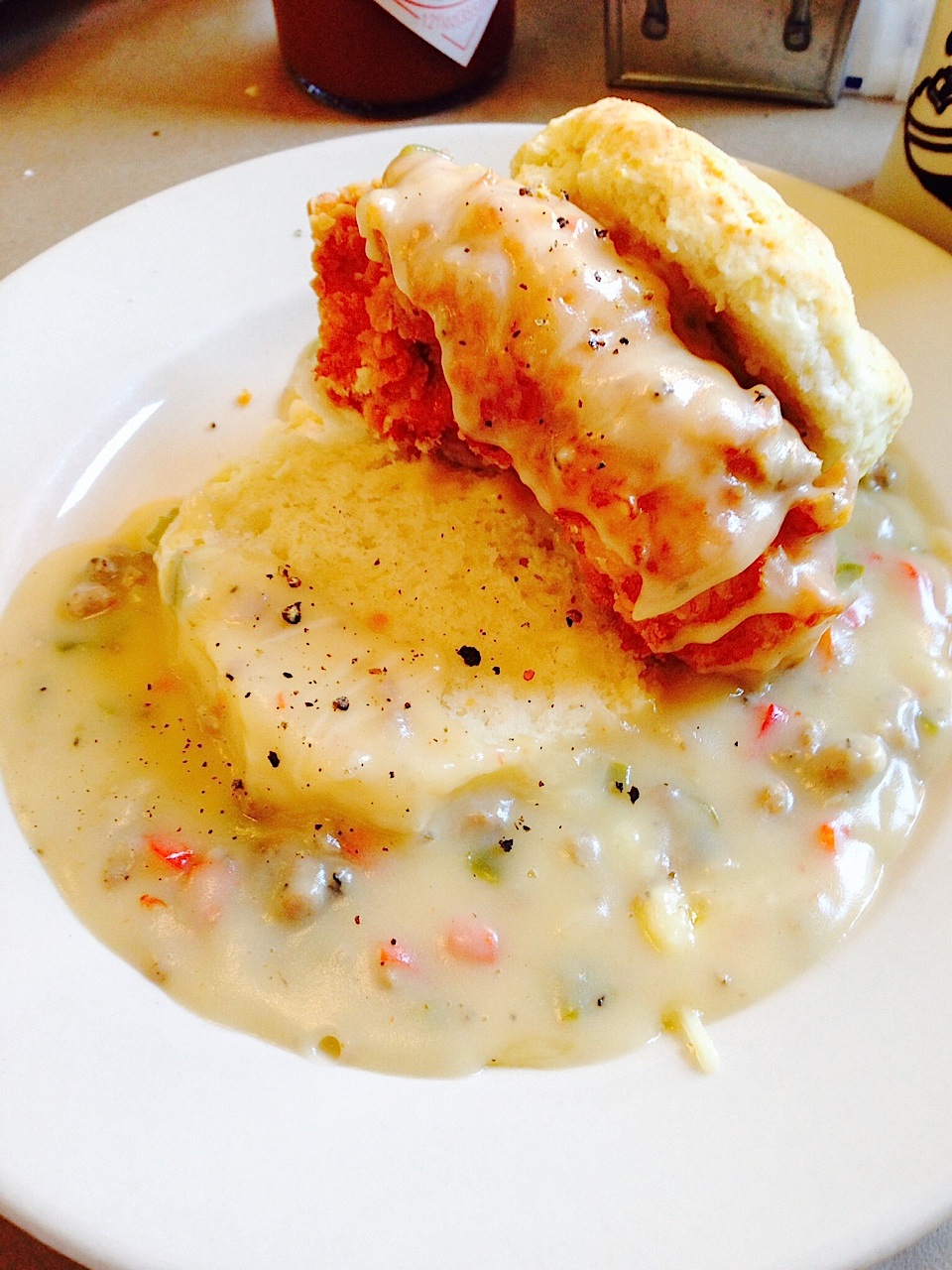
Chef-owner Robert Stehling cooks
up all the old dishes, like soft shell crabs with
baked cheese grits, a curried chicken dish called
country captain, pork with Creole sauce, and, if you
come for breakfast, scrambled eggs, buttermilk
pancakes and country ham. None of which will
cost you very much: nothing tops $20, and those
prices haven’t really inched up in years.
The morning we were there for
brunch, one of the staff had made some “pop tarts,”
absolutely delicious short pastries filled with
fruit paste, perfect fare with the good hot coffee
they serve here. There are salads and
sandwiches here all day, and always a lavish
vegetable plate. Specials are on a blackboard.
You just can't go wrong with
anything. I chose a Sunday special--fried chicken
breast on a huge crumbly biscuit with pan milk
gravy. They call it the Nasty Biscuit (right), and
it’s meant as legit high praise. My wife had a
mushroom and egg torta full
of vegetables all at the right texture. We
polished off a single slice of buttermilk pie and
wanted more.
But there was a plane to catch
and we went home, knowing that next time we’re back,
Hominy Grill will still be there and so will we.
Open for lunch Mon.-Fri., for brunch Sat. & Sun., and for dinner Mon.-Sat.
EDMUND’S OAST
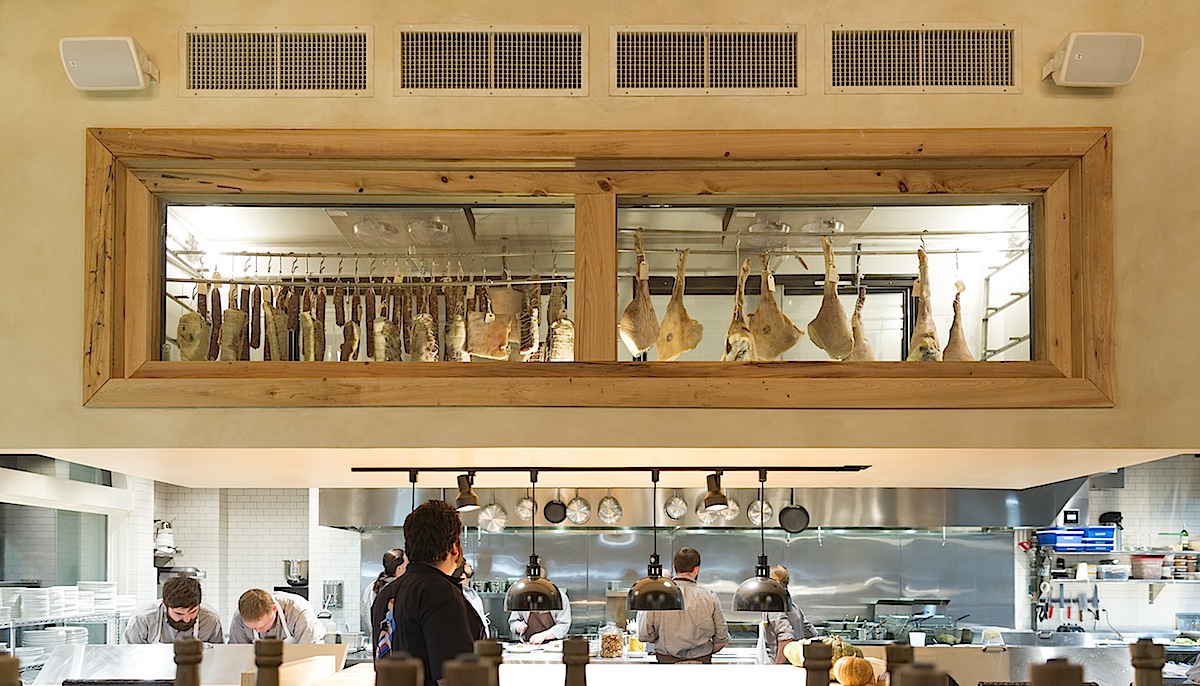 According
to their website, “Edmund Egan was an English-born
brewer who came to Charleston in the 1760s and
started producing beer soon after. He had great
success and donated large amounts of money to the
American Revolution, earning him the name `The Rebel
Brewer.’. Oast is an old European term for a kiln
used in the drying of hops. Together the two make
the name.”
According
to their website, “Edmund Egan was an English-born
brewer who came to Charleston in the 1760s and
started producing beer soon after. He had great
success and donated large amounts of money to the
American Revolution, earning him the name `The Rebel
Brewer.’. Oast is an old European term for a kiln
used in the drying of hops. Together the two make
the name.”
So, this new gastropub pays
homage to the traditions of Southern breweries while
offering a wide array of small plates with which to
enjoy those brews. Owners Scott Shor and Rich Carley are
transplanted New Yorkers who first met in college,
afterwards going their separate ways in business
before moving to Charleston, where they decided to
open the state’s first all craft beer store--The
Charleston Beer Exchange--as a hobby, which, as
hobbies often do, turned into something much
grander, this enormous, 130-seat interior (in good
weather that number will appreciate substantially)
with an arched, wood beam ceiling and a
magnificent wall of craft brews on draft.
But be forewarned: this is one of the most
crashingly, dizzyingly loud restaurants anywhere,
and conversation is nearly impossible when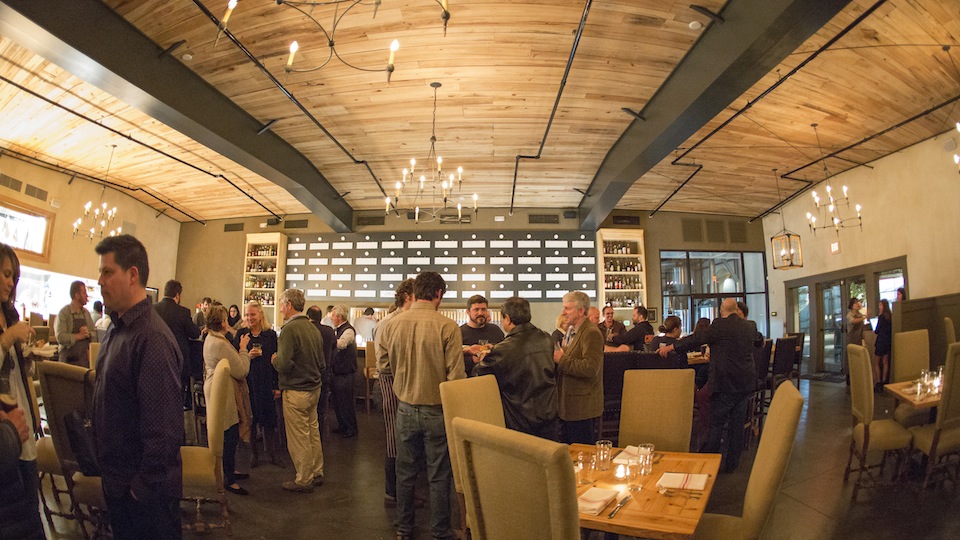 the room is full. Piped-in
music sure doesn't help.
the room is full. Piped-in
music sure doesn't help.
Chef Andy Henderson, a Charleston native, was sous-chef at
Chef Mike Lata’s influential FIG restaurant in town,
traveled widely and returned to take the helm here
at EO. The menu is largely small plates, including
bar snacks--the cornbread ($4) is terrific--a
selection of charcuterie ($12-$20), braised lamb
meatballs with apricots and cider mint ($11), a
bacon-egg-cheeseburger ($16), and desserts that
include pistachio cookies with rose water and
vanilla crème fraîche ($3).
Time will
tell if EO has legs; right now everybody wants to be
there, be seen, drink some excellent fresh draft
beers, and nosh. If it gets a bit tamer in the
future, it will be much more appealing to more
people.
Open nightly for dinner; brunch on Sat. & Sun.
❖❖❖
By John Mariani
By John Mariani
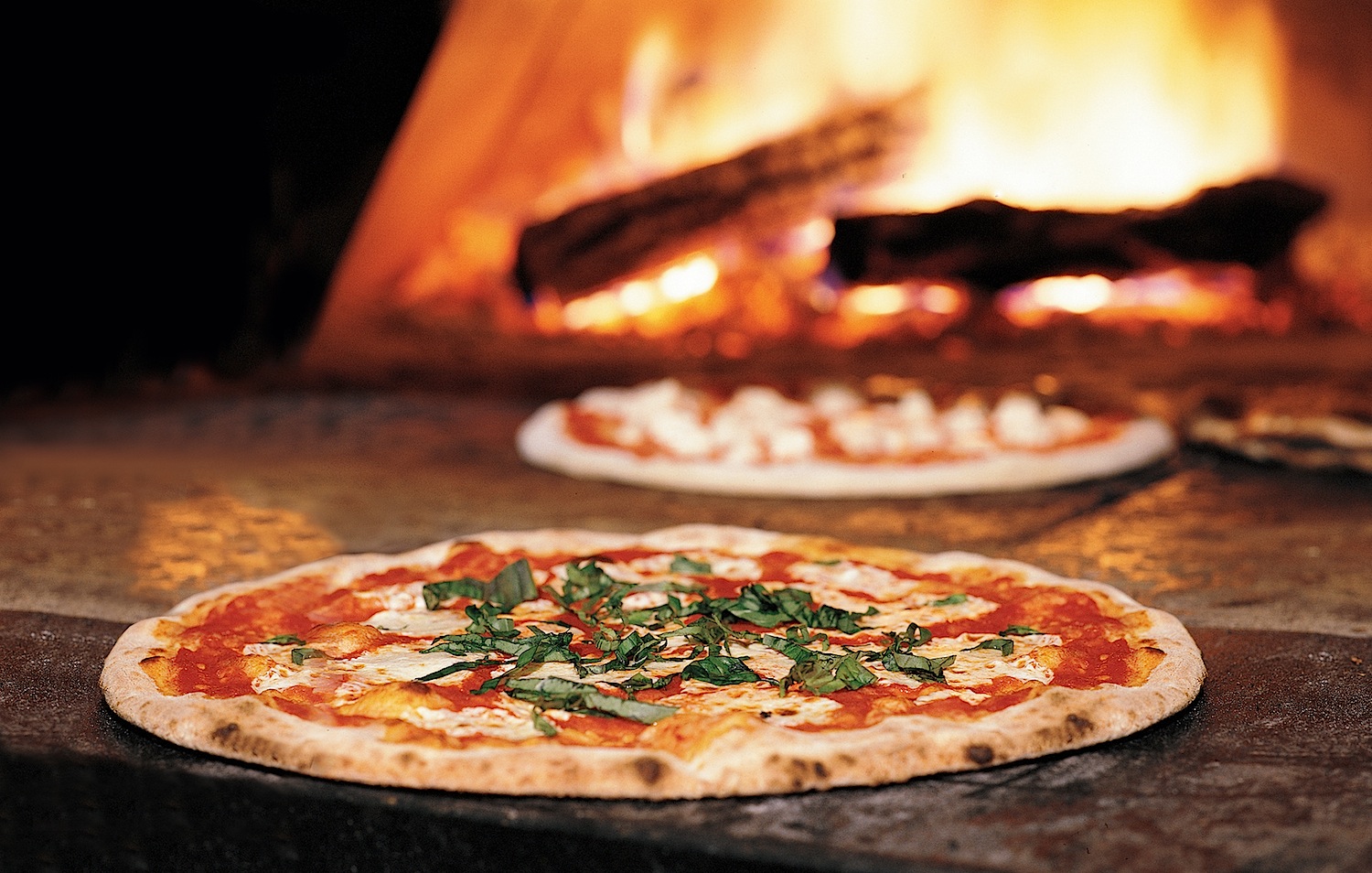
All
the
talk about how dining out has become more casual
obviously ignores the fact that the overwhelming
majority of restaurants are casual, not least--and
especially in New York--the venerable Italian
trattorias, distinct from high-end Italian
ristoranti with Frette linens and 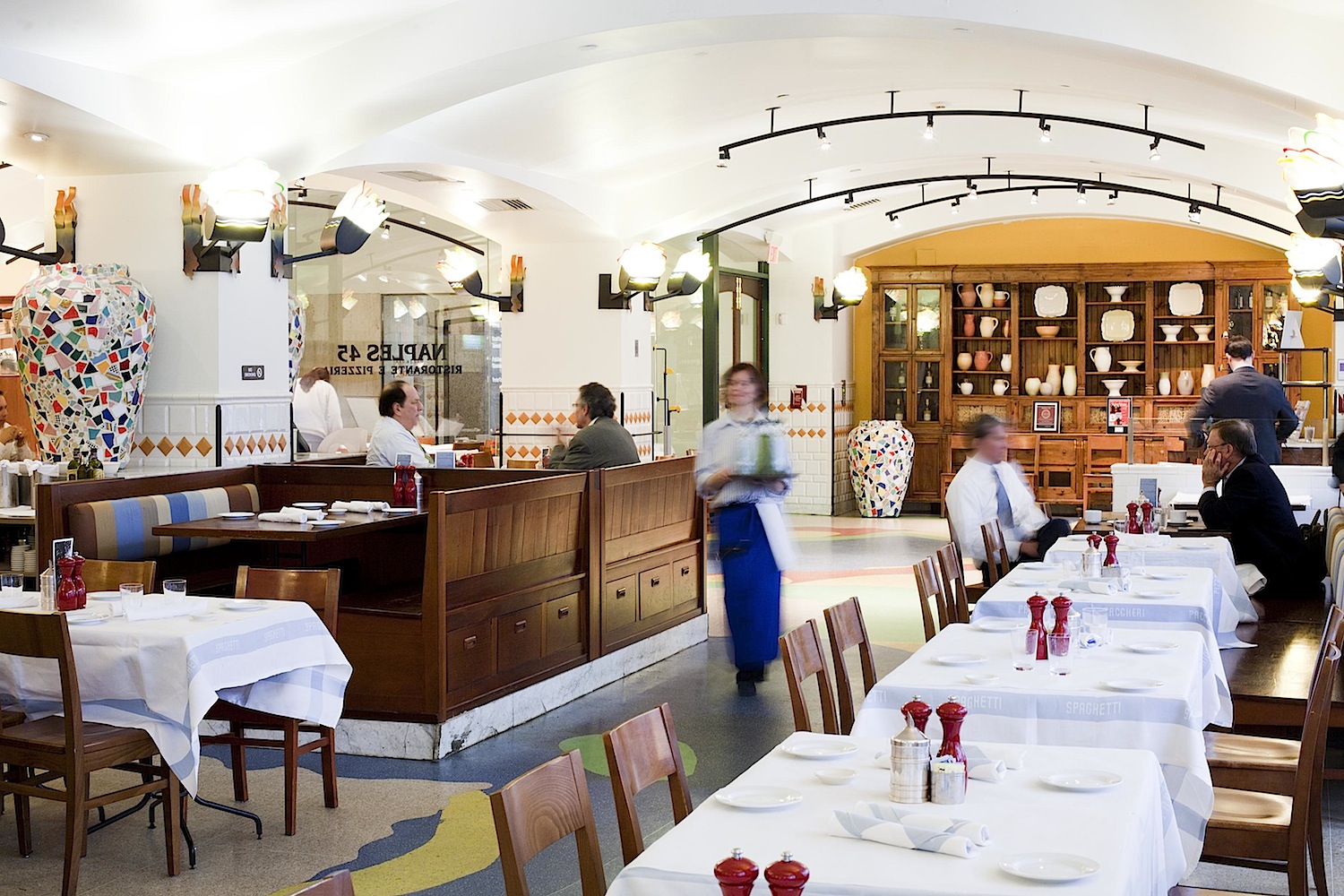 Ginori china. At
the former, they perfected long ago the art of “dolce far niente,”
that is, the sweetness of doing nothing, achieved
through a lot of hard work. The irony is that
not too long ago, pizzerias were quite distinct from
trattorias and ristoranti,
until pizza went from being snack food to a gourmet
item. Today even high-end Italian restaurants serve
the now exalted pies.
Ginori china. At
the former, they perfected long ago the art of “dolce far niente,”
that is, the sweetness of doing nothing, achieved
through a lot of hard work. The irony is that
not too long ago, pizzerias were quite distinct from
trattorias and ristoranti,
until pizza went from being snack food to a gourmet
item. Today even high-end Italian restaurants serve
the now exalted pies.
One
of
the best of the trattoria + pizzeria genre has been
around for a long time--Naples 45,
in the MetLife Building atop Grand Central Terminal.
Back in 1963 this space was called
Trattoria--then a very unfamiliar term to Americans,
and the restaurant was a vast, colorful, very
stylish space serving highly authentic Italian fare
(I still recall its lasagne alla bolognese as the
best in the U.S.). But it didn’t serve pizza.
Decades later Trattoria was recast as Naples 45 (left), the name
referring to the city where pizza was invented back
in the 19th century and to the number of the street
outside the restaurant’s glass wall. A
great deal of research was done to obtain the
perfect flour, tomatoes, mozzarella, even water with
the same mineral content as the water in Naples, and
the result was a glorious pizza (above), which
it remains to this day. Shaped like the Circus
Maximus, the pizzas are impeccably crisp, the right
thickness and steamy with fine ingredients.
They start, in size, at $16.95 and go up to
very large ones at $35.50.
Indeed, I would
contend that it was putting such great pizza on the
menu at Naples 45 that gave the O.K. to other
Italian restaurateurs fearful of adding such a
humble item to their menus. These days there’s
hardly an Italian restaurant in New York, or
anywhere else for that matter, that doesn’t serve
pizza.
Chef
Stephen
Rosenbluth also turns out fine Italian food that
begins with crisp calamari with a spicy tomato sauce
($12) and crumbly arancini
rice balls stuffed with mozzarella and served
with a tomato ragù
($10). The pastas, which come in enormous
portions, include a lasagna bolognese ($19)
that comes pretty close to the one I so loved when
this was Trattoria, and there’s heft and heartiness
in the spaghetti chitarra
with pecorino and coarse black pepper mixed with
runny egg for a creamy finish ($18). The fat
tubes called paccheri
($19.50) take on an admirable Neapolitan-style meat
sauce.
 If
you’ve still room, the striped bass is poached with
clams, tomatoes, capers, garlic, and oregano ($26),
and the crisply breaded chicken cutlet milanese is
piled high with tomatoes, arugula and a sharp red
onion salad ($26).
If
you’ve still room, the striped bass is poached with
clams, tomatoes, capers, garlic, and oregano ($26),
and the crisply breaded chicken cutlet milanese is
piled high with tomatoes, arugula and a sharp red
onion salad ($26).
Prices
on
everything at Naples 45 are extremely reasonable and
you’re likely to take something home. They
also offer a four-course dinner at $32.
Now
that
spring is struggling to arrive, they’ll soon be
opening up the patio tables with their bright blue
umbrellas. Come early: those tables go fast at
lunchtime.
Naples 45 is open for breakfast, lunch
and dinner Mon.-Fri.
A brand
new trattoria, with the forthright name Mozzarella
& Vino, has opened on the former
site of Il Gattopardo (now moved slightly east),
across from the Museum of Modern Art.
Gianfranco and Paula Sorrentino, who also run
the superb ristorante The Leopard across from
Lincoln Center, have here fashioned a long bar and
two dining areas, with a skylight in the back, for
truly casual eating based on the glories of imported
buffalo mozzarella and Italian charcuterie (above)--salami,
salumi, fine hams--and a few antipasto.
The mozzarella comes in several lovely shapes and
varieties, all creamy white and moist, and for $16
you can have a tasting of provola and burrata. There is
smoked mozzarella, eggplant-stuffed mozzarella,
basil-scented mozzarella, and much more. The meats
range from various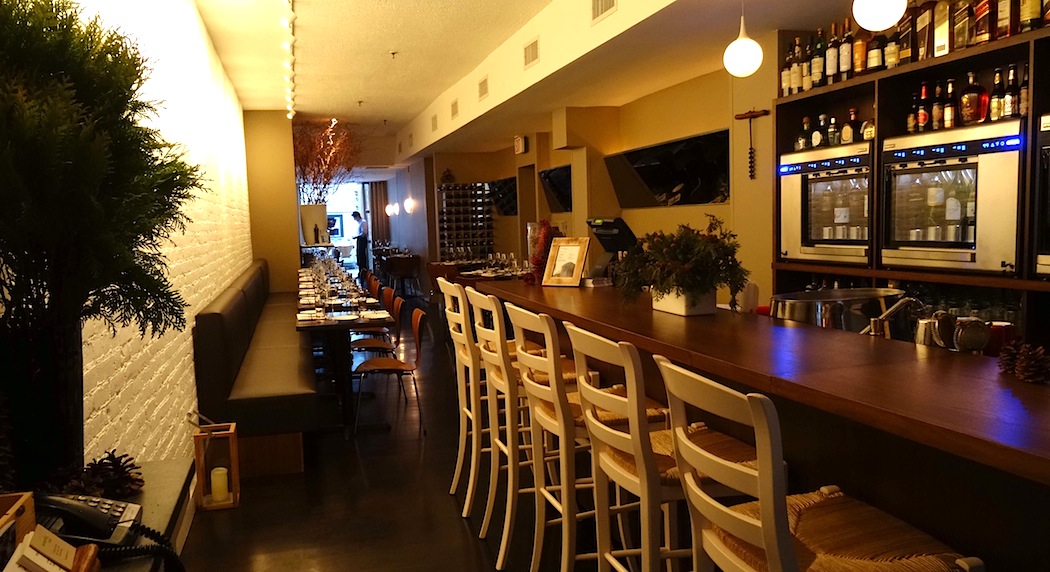 prosciuttos to bresaola, Speck,
mortadella, and rare culatello--all
from the finest producers. For lunch, the
panini sandwiches are a first rate idea with a glass
of wine at the bar.
prosciuttos to bresaola, Speck,
mortadella, and rare culatello--all
from the finest producers. For lunch, the
panini sandwiches are a first rate idea with a glass
of wine at the bar.
You
should
also consider the items from the friggitoria list--fried
dishes, including rice ball arancini, fat panzarotti
pasta filled with potato, mozzarella and salami, and
golden fried zucchini.
There
are
only a couple of pastas here--a vegetable lasagna
and baked pasta of the day--as well as a platter of
meatballs ($13/$19) and hearty beef stew ($18) with
corn polenta.
Mozzarella &
Vino puts great emphasis on the vino part, acting as
an enoteca
where you can order a well-selected range of small
estate wines in two-, four-, or six-ounce glasses.
The
Sorrentinos
offer you a choice on 54th Street--either the posh
Il Gattopardo or this casual new eatery. At both you
can count on the same quality of ingredients and
service, striking a fine casual balance of refined
good taste.
Mozzarella & Vino is open
Mon.-Sat from 11:30 AM to 10 PM, Sundays from 11:30
AM to 5 PM.
~~~
NOTES FROM THE WINE CELLAR
Wines I'm
Drinking for Spring
By John
Mariani

Perhaps the title of this article is too
optimistic, for spring has yet to settle into
the Northeast.
But I did see crocuses rearing their
purple heads this morning, so I will drink wines
accordingly.
In
early spring you can certainly still drink
big-bodied red wines, and there are so many good
ones from so many global vineyards right now in
the marketplace, at just about every price
point. Here is a slew I’m enjoying right now.
Argento
Reserva Malbec 2010 ($14)—The
characteristic flavor of Malbec, with its strong
tannins, makes this wine a primer for the fine red
wines of this varietal now coming out of Mendoza
vineyards in Argentina. It’s very well priced for
the quality, especially since Argento only started
making Malbec as recently as 1998. The
wine spends nine months in oak barrels, softening
it to its present equilibrium.
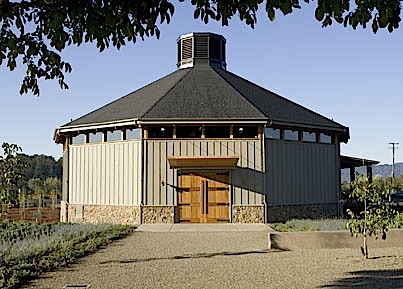 Duckhorn Paraduxx
Winery C Blend 2009 ($48)—Here’s a fine
blend of cabernet sauvignon and zinfandel, with
the latter providing dark fruit and a
tobacco-and-chocolate finish. At 14.5 percent
alcohol it’s just at that sweet spot where big
means bold. The winery was founded in 1994 and
opened to the public in 2005 in Napa Valley and is
well worth visiting for its round barn
architecture and state-of-the-art facilities (left).
Duckhorn Paraduxx
Winery C Blend 2009 ($48)—Here’s a fine
blend of cabernet sauvignon and zinfandel, with
the latter providing dark fruit and a
tobacco-and-chocolate finish. At 14.5 percent
alcohol it’s just at that sweet spot where big
means bold. The winery was founded in 1994 and
opened to the public in 2005 in Napa Valley and is
well worth visiting for its round barn
architecture and state-of-the-art facilities (left).
Penfolds
St. Henri Shiraz 2009 ($65)—Penfolds is
one of Australia’s pioneering wineries in the
Barossa Valley and they make a wide range of
products at various prices. This is
getting to the top of the line and is very
expressive of how Australian shirazes manage to
retain fruit without being inky . . .. To really
hit the heights, sell an antique at get the
Penfolds Bin 707 ($265), but be prepared to wait
for it to come 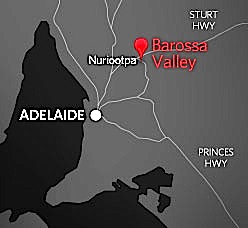 to full
maturity. Right
now there is magnificence lurking beneath the
fruit, acid and, curiously subdued, tannins.
to full
maturity. Right
now there is magnificence lurking beneath the
fruit, acid and, curiously subdued, tannins.
Robert
Mondavi Napa Valley Chardonnay 2012
($19)—Here's a good entry level premium chardonnay
from the estate that created the California style
for the varietal.
There’s oak and caramel here but enough
acid for balance, and I found it tasted even
better the next night when some oxygen got
absorbed into the wine.
Steven
Kent Folkendt Vineyard 2010 ($65)—a
Livermore Valley, CA, 100 percent Cabernet
Sauvignon whose alcohol of 14.2 percent is
admirable in a state that loves huge, out-of-whack
cabs. Full
fruited, it is lively on the palate and has a
fine, long finish that will be even better in 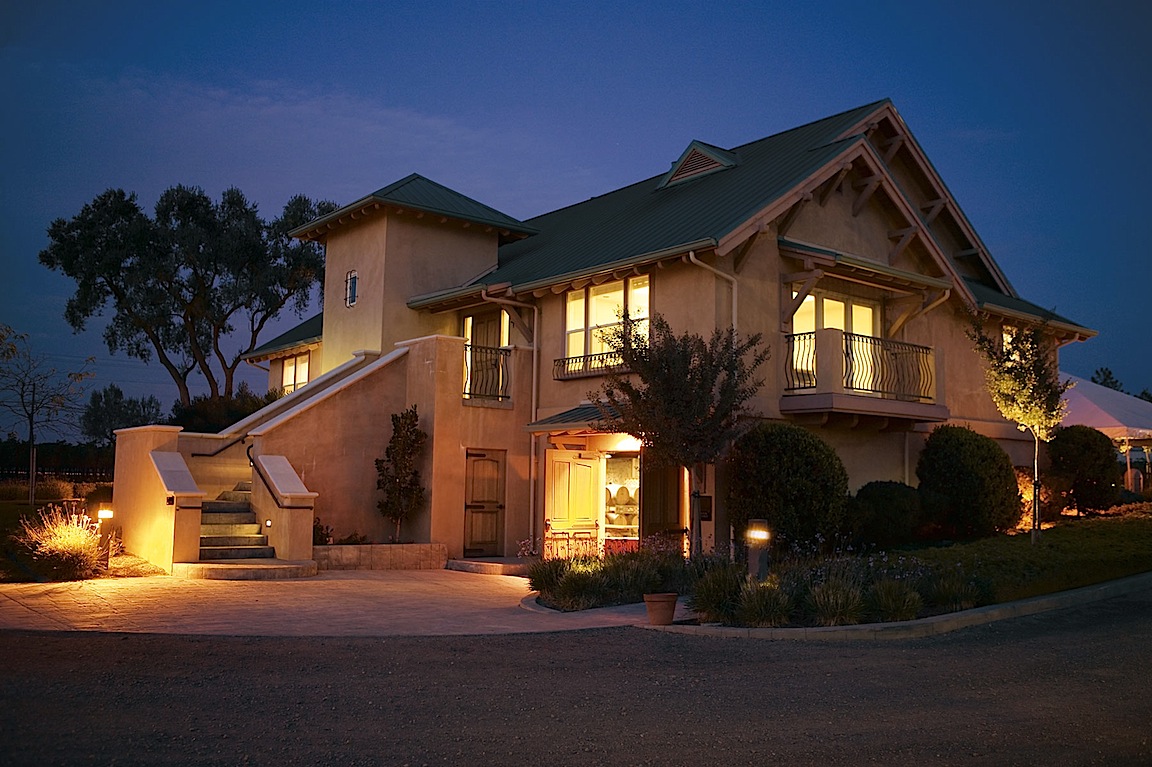 two to three years.
two to three years.
Li
Veli Pezzo Morgana Negroamaro Salice Salentino
2008 ($20)—Salice Salentino made from the
Negroamaro grape is Puglia’s claim to red wine
quality, and this distinctive varietal is ripe and
ready to drink right now with red meats. I found
some sediment in the bottle, which suggests it
won’t be this delicious forever.
Brolio
Riserva Chianti Classico 2010 ($30)—A
remarkable price for such a beautifully crafted
Chianti Classico in a blend of 80 percent
Sangiovese, a soft 15 percent Merlot, and a
backbone of 5 percent Cabernet Sauvignon, spending
16 months in oak and three in bottle. It is
ideal with the kinds of 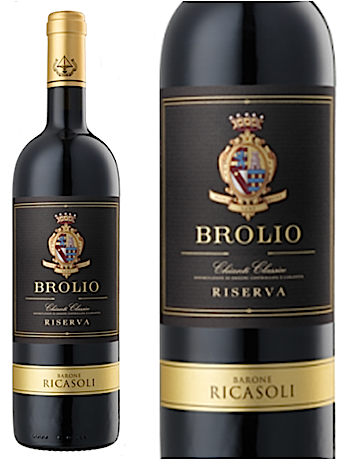 foods
enjoyed in Tuscany and right now the baby lamb is
being readied for Easter, when this wine would be
perfect as a celebratory accompaniment.
foods
enjoyed in Tuscany and right now the baby lamb is
being readied for Easter, when this wine would be
perfect as a celebratory accompaniment.
Veramonte
Primus Cabernet Sauvignon 2010 ($14)—The
Colchagua Valley of Chile has emerged as one of
the country’s finest, and this Cabernet (with 5
percent Syrah) made by Huneeus Vintners shows how
you put steel into a velvet glove and have both
power and finesse in an intensely flavorful,
admirably priced red wine. More
age will bring it into even better focus.
❖❖❖
BIDDING ON THE ITEM WILL BEGIN AT 50,000£ AT SOTHEBY'S
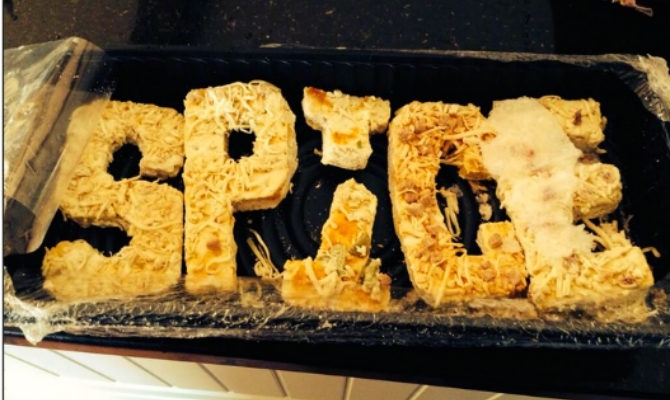
Victoria Beckham (aka Posh
Spice) recently tweeted a photo of a box of
vintage Spice Girls pizza, for which each girl had
her own slice shaped like a letter in the word
SPICE. According to E! Online, Mel C’s “S” slice
had tuna and cheese, Emma’s “P” slice had ham and
cheese, Geri’s “I” had chilies and cheese, Mel B’s “C”
had spicy beef and cheese, and Victoria’s “E” had red
onions because “she knows what she wants, what she
really, really wants when it comes to vegetables”
(according to the box).

HMMM, WE ALSO SEEM TO
DETECT. . . MOSCOW
SEWERAGE. . . FLORIDA SWAMP. . . AND A TOUCH,
JUST A TOUCH, OF AMAZONIAN LOG ROT.
"The 1970 Jurançon Sec from Clos Joliette is a
legendary wine - and deservedly so. It has a potent nose
that knocks your olfactory senses sideways for a moment.
`Peculiar' is the word I wrote down initially. Then it
begins to reveal some lovely notes of
tangerine, dried pineapple, Thai fish oil and adhesive
glue. The palate is well balanced and comes armed with
searing bone dryness. There is a pleasant waxy texture
in the mouth with touches of marmalade on the saline
finish that packs a might punch Wow. Not for the faint
hearted, but electrifying to the senses. Tasted August
2013."--Neal
Martin, eRobertParker
Any of John Mariani's
books below may be ordered from amazon.com.
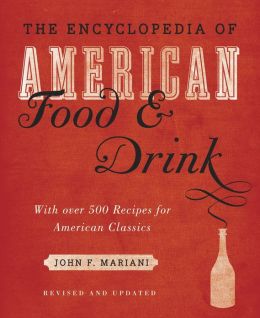 |
The Encyclopedia of American Food and Drink by John F. Mariani (Bloomsbury USA, $35) Modesty forbids me to praise my own new book, but let me proudly say that it is an extensive revision of the 4th edition that appeared more than a decade ago, before locavores, molecular cuisine, modernist cuisine, the Food Network and so much more, now included. Word origins have been completely updated, as have per capita consumption and production stats. Most important, for the first time since publication in the 1980s, the book includes more than 100 biographies of Americans who have changed the way we cook, eat and drink -- from Fannie Farmer and Julia Child to Robert Mondavi and Thomas Keller. "This book is amazing! It has entries for everything from `abalone' to `zwieback,' plus more than 500 recipes for classic American dishes and drinks."--Devra First, The Boston Globe. "Much needed in any kitchen library."--Bon Appetit. |
"Eating Italian will never be the same after reading John Mariani's entertaining and savory gastronomical history of the cuisine of Italy and how it won over appetites worldwide. . . . This book is such a tasteful narrative that it will literally make you hungry for Italian food and arouse your appetite for gastronomical history."--Don Oldenburg, USA Today. "Italian
restaurants--some good, some glitzy--far
outnumber their French rivals. Many of
these establishments are zestfully described
in How Italian Food Conquered the World, an
entertaining and fact-filled chronicle by
food-and-wine correspondent John F.
Mariani."--Aram Bakshian Jr., Wall Street
Journal.
"Equal parts
history, sociology, gastronomy, and just
plain fun, How Italian Food Conquered the
World tells the captivating and delicious
story of the (let's face it) everybody's
favorite cuisine with clarity, verve and
more than one surprise."--Colman Andrews,
editorial director of The Daily
Meal.com. "A fantastic and fascinating
read, covering everything from the influence
of Venice's spice trade to the impact of
Italian immigrants in America and the
evolution of alta cucina. This book will
serve as a terrific resource to anyone
interested in the real story of Italian
food."--Mary Ann Esposito, host of PBS-TV's
Ciao
Italia. "John Mariani has written the
definitive history of how Italians won their
way into our hearts, minds, and
stomachs. It's a story of pleasure over
pomp and taste over technique."--Danny Meyer,
owner of NYC restaurants Union Square
Cafe, The Modern, and Maialino.
|
 |
 |
 |
 |
 |
 |
 |
 |
 Everett Potter's Travel Report:
Everett Potter's Travel Report: 
 Eating Las
Vegas is the new on-line site for
Virtual Gourmet contributor John A. Curtas.,
who since 1995 has been commenting on the
Las Vegas food scene and reviewing
restaurants for Nevada Public Radio.
He is also the restaurant critic for KLAS
TV, Channel 8 in Las Vegas, and his past
reviews can be accessed at KNPR.org.
Click on the logo below to go directly to
his site.
Eating Las
Vegas is the new on-line site for
Virtual Gourmet contributor John A. Curtas.,
who since 1995 has been commenting on the
Las Vegas food scene and reviewing
restaurants for Nevada Public Radio.
He is also the restaurant critic for KLAS
TV, Channel 8 in Las Vegas, and his past
reviews can be accessed at KNPR.org.
Click on the logo below to go directly to
his site.

Tennis Resorts Online: A Critical Guide to the World's Best Tennis Resorts and Tennis Camps, published by ROGER COX, who has spent more than two decades writing about tennis travel, including a 17-year stretch for Tennis magazine. He has also written for Arthur Frommer's Budget Travel, New York Magazine, Travel & Leisure, Esquire, Money, USTA Magazine, Men's Journal, and The Robb Report. He has authored two books-The World's Best Tennis Vacations (Stephen Greene Press/Viking Penguin, 1990) and The Best Places to Stay in the Rockies (Houghton Mifflin, 1992 & 1994), and the Melbourne (Australia) chapter to the Wall Street Journal Business Guide to Cities of the Pacific Rim (Fodor's Travel Guides, 1991).


MARIANI'S VIRTUAL GOURMET
NEWSLETTER is published weekly. Editor/Publisher: John
Mariani.
Editor: Walter Bagley. Contributing Writers: Christopher Mariani,
Robert Mariani, John A.
Curtas, Edward Brivio, Mort Hochstein, Suzanne
Wright, and Brian Freedman. Contributing
Photographers: Galina Stepanoff-Dargery,
Bobby Pirillo. Technical Advisor: Gerry McLoughlin.
© copyright John Mariani 2014
